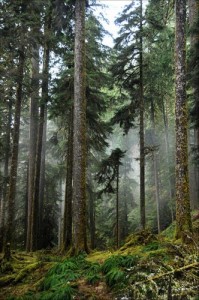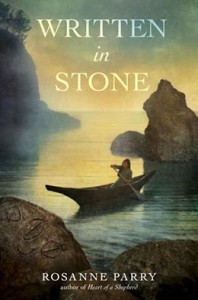I’ve been having an ongoing conversation with Debbie Reese on her blog about Written in Stone. She did a review of the book and brought up lots of good questions which I’ve been gradually answering here and also in the comment section of her blog. I’d really encourage you to head over there an take a look. The link is highlighted above.
Debbie mentioned in her review that the bit about a child playing pirates and indians took her by surprise and she wondered if there was a story there. So here are my thoughts on that.
The word or phrase that pulls the reader out of the story is sometimes a flaw in in the author’s word choices and sometimes the inevitable result of what the reader brings to the page, but sometimes it is the intention of the author to invite a reader to pause outside of the story for a moment and reflect. Such is the case with the pirates and indians remark in Written in Stone. The reader is naturally expecting the phrase cowboys and indians so the pirate reference invites the observation that there no cowboys in this story and no horses.
Most Americans associate horses and teepees with Native Americans but that’s a very narrow picture of the more than 500 nations that reside here. The Quinault and Makah have never been horse cultures. The Olympic Peninsula gets 15 feet of rain a year. It’s part of the only temperate rainforest in North America.It’s very difficult to keep horses alive in such a wet climate and there’s nothing that grows natively for them to eat. These tribes are a maritime culture, two of the many tribes of the Pacific who make ocean going canoes. Their navigational skills are impressive. Historically they traveled as far north as Alaska and up the Columbia to Celilo Falls. Extensive canoe journeys are still made regularly. Most recently the Quinaults hosted an event which gathered hundreds of people from the native cultures of the Pacific who traveled to Taholah by canoe.

I am so pleased my cover artist Richard Tuschman chose a canoe for the cover of this book. I’m also thrilled that Random House paid attention to the lack of children of color on book covers in general and made sure Pearl appeared–not in silhouette–on the cover of this one.
There is a story about a contact between Spanish Pirates and the Quinaults which predates their contact with English speaking settlers. As the story goes the Quinaults resisted the pirates so fiercely at see that the Spanish fled and no Spanish ship ever landed on their shores again. It’s impossible to verify an event this old, but as used in the story as a passing reference, it doesn’t matter. The Spanish did travel in these waters. The Quinaults had experience fighting at sea. If it didn’t happen, it could have which is evidence enough for a work of fiction. If you’d like to learn a little bit more about the Quinault Canoe Society here is a link to their Facebook page.
The larger purpose of the reference though is to invite a conversation about what makes this ecosystem and this tribe and this culture different from other Native American tribes with which my reader may be more familiar. In my opinion the conversation that happens because of a book is far more important than anything that’s actually in the book. Which I why I’m grateful for the conversation Debbie and I are having about this Written in Stone.

Rosanne,
At my site, your readers can see my review, followed by the conversation you and I are having. Here’s the link: http://americanindiansinchildrensliterature.blogspot.com/2014/03/rosanne-parrys-written-in-stone.html
And here’s my reply to the comment above (it also appears at my site).
I thought the support for your use of “pirates and Indians” would be that, in your research, you had found the phrase being used by a Makah in the 1920s.
What you offer instead is an awareness of history and material culture of the Makah, and, why you used that awareness to use “pirates” instead of “cowboys” when you have Pearl say that “pirates and Indians was our favorite game” (p. 42).
I appreciate your explanation, but I don’t buy that Pearl’s favorite game in 1920 would be to play pirates and Indians.
Here’s why:
There is evidence of non-Native people dressing up to play Indian. Philip Deloria documents this quite well in his PLAYING INDIAN, published by Yale University Press in 1999.
Playing Indian (doing what was perceived to be Indian things) arose out of a desire to carve out an American identity that, in various ways, emulated Native peoples in the US, thereby making an American identity distinct on an international stage. Boy scouts played Indian, and secret societies also played Indian. An affinity for doing that became pervasive in American society.
The question at hand is: did Native children do it, too, in the 1920s? How did Pearl know what that form of play looked like? She’d have to know about stereotypes of Indians that were used to play pirates/cowboys and Indians, wouldn’t she?
Where did Pearl get that information?
Elsewhere in her book, Parry has white children pretending to be Indians by war whooping and shooting arrows at Pearl. With that scene, she suggests that the idea of playing Indian in the 1920s involved war whooping and shooting arrows at others. Given that all the way back in 1773, Bostonians war whooped as they threw tea into Boston Harbor, the war whooping part works. The shooting arrows? I’m not sure.
To carry Rosanne’s explanation a bit further, wouldn’t Pearl have been playing Pirates and Makahs, rather than Pirates and Indians? What would playing Pirates and Makahs look like? It helps to frame this in my own world, at Nambe Pueblo. Historically, our wars were with the Spanish, too, specifically the conquistadors and Catholic church. According to Rosanne’s explanation, we would play Conquisator’s and Indians, or, Conquistadors and Pueblos.
The thing is, I can’t imagine someone from Nambe who was the same age as Pearl in the 1920s, playing Conquistador and Pueblo, OR, Conquistador and Indian.
I don’t think playing Indian was something Native children did as a matter-of-course. Of course, I cannot know that definitively, and as many will point out, Parry’s book is a work of fiction, so she can write what she wishes. Still, as her responses to my review indicate, she’s striving to get it right.
Where I end up is this: Even if we replace cowboy with pirate, I don’t think Native kids played that way, and that is why I said “huh?” in my review. It doesn’t ring true.
I’m not surprised at all that conquistadors and indians is not a game among tribes of the southwest. Where is the fun? I really can’t fathom how a child would make a game of that. But you and your culture are a very long way from the Pacific northwest. The tribes here fought skirmishes among them selves over the centuries but they aren’t a conquered people in the way that many other tribes in the US and Canada have been. They were skilled traders who had relationships across various cultures and international borders. Presumably there was occasional friction over fishing and fur trapping spots. But they never engaged the US army or the army of another nation. The suppression of the potlatch was a real problem but it was police-type work rather than an engagement of combat. They were never forcibly moved off their land though many have migrated to urban areas for economic reasons.
Also conquistadores are not a part of American popular culture in the way that pirates are. Treasure Island was a widely read book in the 1920s. Errol Flynn didn’t make his first pirate movie until the early 30s but there were quite a few other films, including a version of Treasure Island, in the pirate genre by the early 20s, so they would be in the mental repertoire of the era. And perhaps most importantly there’s a memory of winning against the pirates which makes it a more appealing avenue for play. I did see little boys on the playground in Taholah playing pirates and indians with sticks for swords and clubs. I was surprised as I don’t think I’ve ever seen another group of kids anywhere playing indians either alone or in combination with cowboy characters. But the boys connected it to the pirate story they’d heard and they were using the sort of pirate talk that was common in movies, so it would be a blend of history and pop culture I think, both in my own experience and in the story in the 1920s.